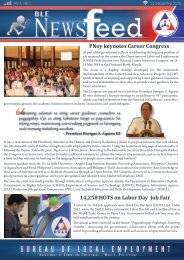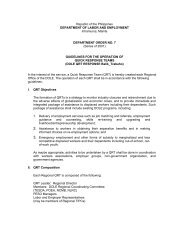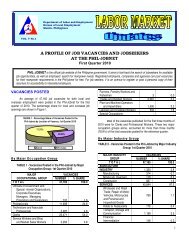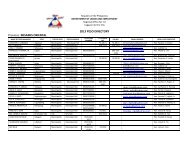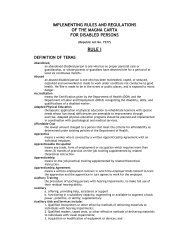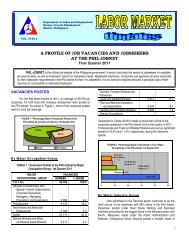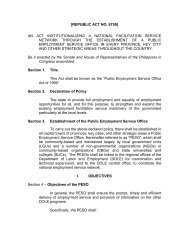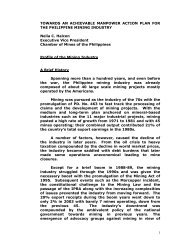Cyberservices - Bureau of Local Employment - DOLE
Cyberservices - Bureau of Local Employment - DOLE
Cyberservices - Bureau of Local Employment - DOLE
Create successful ePaper yourself
Turn your PDF publications into a flip-book with our unique Google optimized e-Paper software.
<strong>DOLE</strong> Workforce Development Summit<br />
<strong>Cyberservices</strong> – The Sectoral Picture<br />
Damian “Dondi” Mapa<br />
CICT Commissioner<br />
March 2006<br />
Commission on Information and Communications Technology
2005 State <strong>of</strong> the Nation Address<br />
[In 2005] the government launched<br />
the Philippine CyberServices<br />
Corridor, an ICT belt stretching over<br />
600 miles from Baguio City to<br />
Zamboanga which is envisioned to<br />
provide a variety <strong>of</strong> cyberservices at<br />
par with global standards.<br />
http://www.news.ops.gov.ph/sona2005-execsummary.htm
“<strong>Cyberservices</strong>” Defined<br />
From Wikipedia: <strong>Cyberservices</strong> are services delivered over<br />
cyberspace. Therefore, "cyberservices" is a catch-all phrase that<br />
includes all <strong>of</strong> the following:<br />
Teleservices (services delivered via phone, such as directory<br />
inquiries or credit card cancellations),<br />
E-Services (discrete transactions serviced via the internet, such as<br />
a tax payment, an e-book download, or an e-learning session),<br />
IT Outsourcing (IT or ICT services, such as remote network<br />
diagnostics or system administration),<br />
IT-enabled services or ITES (batched services, such as digital<br />
animation or copy-editing or medical transcription),<br />
ICT-enabled services (real-time services, such as having <strong>of</strong>fice<br />
receptionists located remotely), and<br />
Business Process Outsourcing or BPO services, such as loans<br />
processing at a remote location.<br />
http://en.wikipedia.org/wiki/<strong>Cyberservices</strong>
<strong>Cyberservices</strong><br />
<strong>Cyberservices</strong><br />
ICT<br />
Services<br />
ICT-Enabled<br />
Services<br />
E-Services<br />
IT<br />
Services<br />
IT-Enabled<br />
Services<br />
Tele<br />
Services
Philippine <strong>Cyberservices</strong> Industry<br />
Total <strong>Employment</strong><br />
101,000 in 2004<br />
163,000 in 2005<br />
266,000 by 2006<br />
403,000 by 2007<br />
569,000 by 2008<br />
795,000 by 2009<br />
1,083,000 by 2010<br />
Total Revenues<br />
$1.3B in 2004<br />
$2.1B in 2005<br />
$3.5B by 2006<br />
$5.2B by 2007<br />
$7.2B by 2008<br />
$9.7B by 2009<br />
$12.8B by 2010<br />
Source: CICT, BOI, BPA/P (See attached exhibits.)
Sidebar:<br />
Hiring Rate vs. Absorption Rate<br />
Hiring Rate<br />
Company measure<br />
Micro-economic<br />
From 3% to 10%<br />
Absorption Rate<br />
Industry measure<br />
Macro-economic<br />
As high as 30%<br />
1 2 3 4 5 6 7 8 9 10 15 20 25 30 35 40 45 50 55 60 70 80 90 100
THE PHILIPPINES’ LABOR SUITABILITY LEADS RUSSIA’S AND CHINA’S<br />
BUT LAGS EASTERN EUROPE<br />
“Of 100 graduates with the correct degree, how many could you employ if you had demand for all?”<br />
Percent<br />
Countries<br />
Engineer<br />
From McKinsey September 2005 Report: The Philippines’ Offshoring Opportunity<br />
Finance/accounting<br />
Generalist<br />
Eastern<br />
Europe<br />
Russia<br />
Czech<br />
10<br />
50<br />
20<br />
40<br />
10<br />
20<br />
Poland<br />
50<br />
30<br />
15<br />
Hungary<br />
50<br />
50<br />
30<br />
Asia<br />
China<br />
10<br />
15<br />
3<br />
Philippines<br />
20<br />
30<br />
25<br />
India<br />
25<br />
15<br />
10<br />
Malaysia<br />
35<br />
25<br />
20<br />
Latin<br />
America<br />
Brazil<br />
Mexico<br />
20<br />
13<br />
13<br />
42* 25 35*<br />
8<br />
11<br />
All suitability rates are empirically based on a total <strong>of</strong> >100<br />
interviews with HR pr<strong>of</strong>essionals working in each country<br />
* Mexico is the only country where interview results (higher number) were adjusted<br />
post mortem since interview base was thinner and risk <strong>of</strong> misunderstanding high<br />
Source:<br />
Interviews with HR managers, HR agencies and Heads <strong>of</strong> Global Resourcing centers; McKinsey Global Institute<br />
<br />
Only for Doctors and Nurses, same suitability rate than for life<br />
science researchers was assumed due to a lack <strong>of</strong> interviews<br />
7
Philippines vs.<br />
India and China<br />
2003 Population (Mil)<br />
Philippines<br />
– 81.6<br />
India<br />
– 1,065<br />
– 13 times bigger<br />
China<br />
– 1,292<br />
– 16 times bigger<br />
2003 BPO Employables*<br />
Philippines<br />
– 60,000<br />
India<br />
– 130,000<br />
– 2 times bigger<br />
China<br />
– 160,000<br />
– 3 times bigger<br />
*IT, CS, and all Engineering (excluding Civil Engineering)<br />
Source: McKinsey Global Institute
Workforce Mobilization<br />
By Source<br />
2.45m college graduates,<br />
2006-2010 450-550k<br />
4m Unemployed,<br />
6m Underemployed 100-120k<br />
1m Overseas Migrant<br />
Workers 100-120k<br />
1m Filipino Diaspora<br />
100k<br />
Career Shifters and<br />
Retirees 100-150k<br />
By Location<br />
Tier 1: Metro Manila, Metro<br />
Cebu, Metro Davao 550k<br />
Tier 2: Baguio, Dagupan,<br />
Cabanatuan, Tarlac, Sta.<br />
Rosa, Batangas, Lipa,<br />
Legazpi, Naga/CamSur,<br />
Bacolod, Tacloban, Iloilo,<br />
Dumaguete, Tagbilaran,<br />
Cagayan de Oro, General<br />
Santos 300k<br />
Emerging: Tagbilaran,<br />
Zamboanga, San Fernando<br />
(La Union), others 150k<br />
Philippine <strong>Cyberservices</strong> Corridor
PGMA on the PCC<br />
President Gloria Macapagal-Arroyo<br />
at the Philippine Investment Conference<br />
March 9, 2005 at Lapu-lapu City, Cebu<br />
“our cyberservices corridor<br />
actually stretches 600 miles from<br />
Baguio in Northern Luzon to<br />
Zamboanga in Mindanao”<br />
“it’s served by a $10B highbandwidth<br />
fiber backbone and<br />
digital network”<br />
President Gloria Macapagal-Arroyo<br />
at the Cebu ICT 2005 Conference<br />
June 22, 2005 at Cebu City, Cebu<br />
“Over the past 12 months call<br />
centers have opened in Iloilo,<br />
Cagayan de Oro, and Baguio. BPO<br />
operations have sprung up in<br />
Legaspi and Tacloban. Medical<br />
transcription centers have been<br />
established in Dumaguete, Davao,<br />
and Naga.”<br />
“the concept <strong>of</strong> the cyberservices<br />
corridor is gaining ground!”<br />
http://www.ops.gov.ph/speeches2005/speech-2005_mar09.htm<br />
http://www.ops.gov.ph/speeches2005/speech-2005_jun22.htm
Benefits <strong>of</strong> the Corridor<br />
Job Generation<br />
– 1 million jobs by 2010<br />
– A new middle class with strong purchasing power<br />
Regional Development<br />
– From Baguio to Zamboanga<br />
– Changing the face <strong>of</strong> the nation<br />
Locator Options<br />
– Cost vis lifestyle vis scalability vis retention<br />
Dispersion <strong>of</strong> Demand<br />
– Minimize wage inflation and poaching/attrition
Issues for<br />
Workforce Development<br />
Common Themes<br />
– Career Advocacy<br />
– Curriculum Review and Faculty Retraining<br />
– English Pr<strong>of</strong>iciency<br />
Segment Specific Needs and Issues<br />
– Animation (prepared by the ACPI)<br />
– S<strong>of</strong>tware Development (prepared by the PSIA)<br />
– Medical Transcription (prepared by the MTIAPI)<br />
– Back Office Processing (prepared by the BPAP)<br />
– Customer Contact (prepared by the CCAP)
Common Themes<br />
Across Segments<br />
Commission on Information and Communications Technology
Career Advocacy<br />
Long-term career option<br />
Prospects for advancement<br />
Quality <strong>of</strong> life issue<br />
Audience: career shifters, parents, highschool<br />
students, college students<br />
Issue: How do we get more Filipinos to be interested in a career in cyberservices?
Curriculum Review<br />
Exposure to application <strong>of</strong> ICT in business<br />
processes<br />
Improved pr<strong>of</strong>iciency in keyboarding and<br />
communication skills<br />
Competency in productivity tools<br />
Faculty retraining to deliver revised<br />
curriculum<br />
Issue: Are we preparing Filipinos to be knowledge workers in an information society?
English Pr<strong>of</strong>iciency<br />
Media, especially TV, has de-emphasized<br />
English<br />
Lack <strong>of</strong> support for use <strong>of</strong> English in<br />
family, society<br />
Lack <strong>of</strong> English teachers<br />
Five (5) “near hires” for every hire<br />
Issue: What can we do to avoid job rejection due to lack <strong>of</strong> English pr<strong>of</strong>iciency?
Recommendations<br />
College<br />
English to be taught all 4<br />
years.<br />
1/3 <strong>of</strong> all English lessons<br />
will be conversational<br />
English.<br />
Retrained English<br />
teachers to run the<br />
English Course for other<br />
teachers throughout the<br />
school term.<br />
High School<br />
1/3 <strong>of</strong> English classroom<br />
time be dedicated to<br />
conversational English.<br />
English-only zones will be<br />
imposed and enforced.<br />
Retrained English<br />
teachers to run English<br />
courses for other<br />
teachers throughout the<br />
school year.
School Initiatives<br />
Negros Occidental,<br />
Camarines Sur,<br />
CALABARZON: High<br />
School and Elementary<br />
English Teachers trained<br />
in the use <strong>of</strong> Small-group<br />
Communicative<br />
Methodology for the<br />
Conversational English<br />
Classroom.<br />
Mapua Institute <strong>of</strong><br />
Technology:<br />
FuturePerfect helping to<br />
develop their English<br />
curriculum and to retrain<br />
English teachers.<br />
Asia-Pacific College: 7<br />
English subjects, with one<br />
on Voice and Accent<br />
Training, supplied by<br />
IBM-Daksh.
Assessment Initiatives<br />
Future Perfect<br />
– Uses certified assessors to rate ability to discourse<br />
and interact using the Business Processing Language<br />
Assessment Scales (BUPLAS)<br />
Prospeak<br />
– Uses computer-generated prompts to test and score<br />
candidates calling into the Prospeak Testing System<br />
BPA/P E4E (English for <strong>Employment</strong>)<br />
– Uses a 5-level assessment tool for oral English<br />
“Near hires” can opt to attend a 100- to 200-hour English training<br />
program that will enable them to interview with BPO companies.
“English is Cool” Campaign<br />
Short term: Call Center and BPO<br />
– 250,000 to reach the required call center level<br />
– Bring the next 1,000,000 to trainable level<br />
Mid-term: trainers & pr<strong>of</strong>essionals<br />
– Train the Teachers programs<br />
– Improve practice among pr<strong>of</strong>essionals in service industries,<br />
management positions<br />
– Enroll 50,000 students or pr<strong>of</strong>essionals into fast-track classes<br />
Long-term: basic education<br />
– More than 450,000 students graduate every year<br />
– Millions in lower grades<br />
Spearheaded by the European Chamber <strong>of</strong> Commerce
PEP Campaign<br />
“Promoting English Pr<strong>of</strong>iciency” (PEP)<br />
– MOA signed in October 2003<br />
– Led by the American Chamber <strong>of</strong> Commerce with 11 member<br />
federations and umbrella organizations; 45 project partners<br />
PEP Components:<br />
Certification<br />
Training<br />
Advocacy
PEP Initiatives<br />
Certification<br />
– Internationally recognized<br />
tests;<br />
– Test <strong>of</strong> English for<br />
International Communication<br />
(TOEIC): most widely used<br />
international standard <strong>of</strong><br />
English pr<strong>of</strong>iciency in the<br />
workplace; and<br />
– Administered in corporations<br />
and schools to employees,<br />
teachers, and students.<br />
Training<br />
– Computer-assisted<br />
learning using DynEd<br />
Multimedia Solutions;<br />
– 15 Computerized English<br />
Language Centers<br />
(CELCs) installed in<br />
various schools and<br />
companies with thousands<br />
already trained; and<br />
– Teacher training by the<br />
Ateneo Center for English<br />
Language Teaching<br />
(ACELT).<br />
PEP Website www.promote-english.org
Segment Concerns<br />
1. Customer Contact<br />
2. Animation<br />
3. S<strong>of</strong>tware Development<br />
4. Medical Transcription<br />
5. Back Office Processing<br />
Commission on Information and Communications Technology
Customer Contact Segment<br />
As <strong>of</strong> 1 st Quarter, 2006<br />
Still the fastest growing segment in the Philippines<br />
Customer Contact Centers in the Philippines: 105<br />
Total Full Time Employees: 112,000<br />
Total Seats: 70,000<br />
Estimated Revenues in 2005: US$ 1.6 B<br />
With a Growth Rate for 2005: 75%
Contact Center Overview<br />
YEAR<br />
No . o f C a ll<br />
C e n ters<br />
E s t. No . o f<br />
S e ats<br />
E s t. No . o f<br />
E m p lo y ee s<br />
E S T . RE V E NUE<br />
(US $ Millio n)<br />
2 0 0 0 4 1 ,5 0 0 2 ,4 0 0 2 4<br />
2 0 0 1 1 3 3 ,5 0 0 5 ,6 0 0 5 6<br />
2 0 0 2 3 1 7 ,5 0 0 1 2 ,000 1 2 0<br />
2 0 0 3 6 0 2 0 ,00 0 3 2 ,000 3 2 0<br />
2 0 0 4 7 2 4 5 ,00 0 6 7 ,000 9 2 0<br />
2 0 0 5 1 0 0 + 7 0 ,00 0 112,0 0 0 1 ,6 0 0<br />
Key Players in the Country<br />
Third Party Providers: Sykes, Convergys, PeopleSupport, Clientlogic,<br />
ePLDT Parlance, ICT Group, Ambergris, Teletech, eTelecare, etc…<br />
Captives: Dell, AOL, JPMorgan, Siemens, HSBC, AIG, IBM Daksh, etc..
Demand Side - Quantitative<br />
Agent Qualifications (Mo. Sal. 10-25k)<br />
– Educational Attainment: majority with 2-4<br />
years college education; for technical support<br />
- ICT-related courses<br />
– Additional Training<br />
• Pre-hire: English pr<strong>of</strong>iciency/interview<br />
skills (100+ hours)<br />
• Internal or outsourced: s<strong>of</strong>t skills (40-80<br />
hours <strong>of</strong>: accent neutralization, oral<br />
fluency and accuracy, culture training,<br />
customer service, business writing) ;<br />
sales and telemarketing for outbound<br />
• Internal: product training (2-6 weeks)<br />
– Work Experience: n/a<br />
– Skills/Competencies: English pr<strong>of</strong>iciency (oral<br />
and written), computer literacy, customer<br />
service aptitude<br />
• Languages in demand: Spanish,<br />
French, Mandarin, Cantonese, Korean,<br />
Japanese, etc.Oral and written<br />
pr<strong>of</strong>iciency a plus (commands salary<br />
premium)<br />
– Certifications<br />
• TESDA Certification for Contact Center<br />
Agent (planned)<br />
– Others: willingness to work on shifts<br />
Team Leader/Supervisor Qualifications (Mo. Sal.<br />
20-35k)<br />
– Educational Attainment: same as Agent<br />
– Additional Training: same as Agent,<br />
Leadership programs;<br />
– Work Experience: typically 1-3 years as an<br />
agent<br />
– Skills/Competencies:<br />
supervisory/coaching/leadership skills<br />
– Certifications: n/a<br />
– Others: willing to work in shifts; demonstrated<br />
managerial maturity<br />
Middle Manager Qualifications (Mo. Sal. 50-100k)<br />
– Educational Attainment: same as Agent<br />
– Additional Training: same as Supervisor; plus<br />
Business Management training<br />
– Work Experience: typically 2-3 years as<br />
supervisors, or 1-2 years as managers<br />
– Skills/Competencies:<br />
supervisory/coaching/leadership skills;<br />
account management skills; project planning<br />
and management<br />
– Certifications: n/a<br />
– Others: willing to work in shifts; demonstrated<br />
managerial maturity
Demand Side - Qualitative<br />
Growth is expected to continue, with labor demand<br />
peaking at 85,000 per year. However actual demand will<br />
peak closer to 185,000 due to a large number (20%) <strong>of</strong><br />
workers exiting the segment each year.<br />
Historical<br />
Forecast<br />
2004 2005 2006 2007 2008 2009 2010<br />
Total Employees 64,000 112,000 179,200 259,800 337,700 422,100 506,500<br />
Incremental Growth 48,000 67,200 80,600 77,900 84,400 84,400<br />
Growth Rate 75% 60% 45% 30% 25% 20%<br />
Factors Exited the Industry (20%) 35,800 52,000 67,500 84,400 101,300<br />
Actual Demand 103,000 132,600 145,400 168,800 185,700<br />
Expected Sources <strong>of</strong> Labor Pool<br />
College Graduates 66,950 86,190 94,510 109,720 120,705<br />
Non-degree 15,450 19,890 21,810 25,320 27,855<br />
Career Shifters 20,600 26,520 29,080 33,760 37,140<br />
103,000 132,600 145,400 168,800 185,700
Supply Side - Capacity<br />
Last year (2005), approximately 45,000 college<br />
graduates joined this segment. This year, 67,000<br />
graduates are needed. If this year’s graduate pool is only<br />
as good as last year’s, the 2006 shortfall is 22,000.<br />
Shortfalls are also predicted for 2007-2010 unless drastic<br />
changes are undertaken to improve screening rates and<br />
interest levels.<br />
2006 2007 2008 2009 2010<br />
How many graduates are needed? 66,950 86,190 94,510 109,720 120,705<br />
How many graduates with the right degree? 302,914 314,817 326,721 338,626 350,527<br />
How many pass initial screening? 35% 40% 40% 45% 45%<br />
106,020 125,927 130,688 152,382 157,737<br />
How many are interested? 42% 42% 45% 50% 60%<br />
44,528 52,889 58,810 76,191 94,642<br />
What is the forecast shortfall? (22,422) (33,301) (35,700) (33,529) (26,063)
What needs to be done?<br />
Career Advocacy to Parents, Students, Career<br />
Shifters (to increase interest level)<br />
English Pr<strong>of</strong>iciency Assessment and Pre-hire<br />
Training (to increase passing rate)<br />
Life Adaptation Seminars and Lifestyle Support<br />
e.g. 24x7 Support Services such as Sports Gyms,<br />
Banks, Dental and Health Care, Entertainment (to<br />
reduce exit rate)<br />
Keyboarding Pr<strong>of</strong>iciency<br />
Supervisory Skills Training<br />
Industry Certification<br />
Improved English Faculty/Training in Schools
Segment Concerns<br />
1. Customer Contact<br />
2. Animation<br />
3. S<strong>of</strong>tware Development<br />
4. Medical Transcription<br />
5. Back Office Processing<br />
Commission on Information and Communications Technology
Animation Industry<br />
As <strong>of</strong> 1st Quarter, 2006<br />
– Total animation studios in the country: 40<br />
– Twenty (20) years in the Philippines<br />
– Total Full Time Employees: 4,500<br />
– Est Revenues in 2005: US$ 54 Million<br />
– With a Growth Rate in 2005: 38%<br />
Capabilities:<br />
2D, 3D<br />
Interactive Gaming (PC Gaming & Console Games)<br />
Medical Animation<br />
Visualization<br />
e-Learning Courses
Animation Industry<br />
Key Players in the Country:<br />
Holy Cow! Animation, Artfarm Asia, Digital Exchange, Top Draw<br />
Animation, Toei Animation, Top Peg Animation and Creative Studio,<br />
Creative Asia,Geebo Digital, Toon City, etc…<br />
Flicks Outsourced to the Philippines:<br />
Tom & Jerry, The Jetsons, Adams Family, Scooby Do, The Mask,<br />
Dragonball Z, Lilo & Stich, The Incredibles, Dexter Laboratories,<br />
Power Puff Girls, 1 Piece, etc…
Demand Side - Quantitative<br />
Historical<br />
Forecast<br />
2004 2005 2006 2007 2008 2009 2010<br />
Total 3,000 4,500 6,800 9,900 13,900 18,800 24,400<br />
Incremental 1,500 2,300 3,100 4,000 4,900 5,600<br />
Growth Rate 50% 50% 45% 40% 35% 30%<br />
Factors Exited the Industry (5%) 340 500 700 940 1,220<br />
Actual Demand 2,640 3,600 4,700 5,840 6,820<br />
By Type <strong>of</strong> Skill<br />
Entry-level Animators 100 60% 1,571 2,143 2,798 3,476 4,060<br />
TP/IB Checkers 20 12% 314 429 560 695 812<br />
Key/BG Checkers 20 12% 314 429 560 695 812<br />
Key Animators 20 12% 314 429 560 695 812<br />
Directors 3 1.8% 47 64 84 104 122<br />
Production Managers 1 0.6% 16 21 28 35 41<br />
Production Assistants/Coordinators 2 1.2% 31 43 56 70 81<br />
Trainors 2 1.2% 31 43 56 70 81<br />
Total 168 100% 2,640 3,600 4,700 5,840 6,820
Demand Side - Qualitative<br />
Entry-level Animator Qualifications (Mo. Sal. 8–12k)<br />
– Educational Attainment: preferably high<br />
school graduate<br />
– Additional Training: in-house course for inbetweening,<br />
clean-up (3 – 6 months)<br />
– Work Experience: n/a<br />
– Skills/Competencies: drawing, reading<br />
– Certifications: n/a<br />
– Others: willing to work overtime and under<br />
tight deadline pressure<br />
Key Animator Qualifications (Mo. Sal. 15–25k)<br />
– Educational Attainment: at least high school<br />
graduate<br />
– Additional Training: enhanced in-betweening<br />
– Work Experience: 3-5 yrs experience as inbetweener<br />
– Skills/Competencies: advanced inbetweening,<br />
storyboard interpretation,<br />
character development, communication skills<br />
– Certifications: n/a<br />
– Others: willing to work overtime and under<br />
tight deadline pressure<br />
TP/IB Checker Qualifications (Mo. Sal. 10–12k)<br />
– Educational Attainment: preferably high<br />
school graduate<br />
– Additional Training: n/a<br />
– Work Experience: at least 2-3 yrs as painter,<br />
in-betweener<br />
– Skills/Competencies: interpretation <strong>of</strong><br />
exposure sheets, instruction sheets<br />
– Certifications: n/a<br />
– Others: recognized for quality work, willing to<br />
work overtime and under tight deadline<br />
pressure<br />
Key/BG Checker Qualifications (Mo. Sal. 10–12k)<br />
– Educational Attainment: preferably high<br />
school graduate<br />
– Additional Training: n/a<br />
– Work Experience: at least 2-3 yrs as painter,<br />
in-betweener<br />
– Skills/Competencies: storyboard<br />
interpretation, communication skills, works<br />
well with director, exposure to acting/theater<br />
arts, sensitivity to cultural nuances<br />
– Certifications: n/a<br />
– Others: recognized for quality work, willing to<br />
work overtime and under tight deadline<br />
pressure
Demand Side - Qualitative<br />
Director Qualifications (Mo. Sal. 60–100k)<br />
– Educational Attainment: n/a<br />
– Additional Training: in-house on-the-job<br />
training with pr<strong>of</strong>iciency exam<br />
– Work Experience: 10 years in the media arts,<br />
preferably with experience as assistant<br />
director<br />
– Skills/Competencies: exceptional storytelling<br />
skills and ability to interpret script<br />
– Certifications: n/a<br />
Assistant Director Qualifications (Mo. Sal. 40–60k)<br />
– Educational Attainment: n/a<br />
– Additional Training: in-house on-the-job<br />
training with pr<strong>of</strong>iciency exam<br />
– Work Experience: 5 years in the media arts,<br />
preferably with experience as checker<br />
– Skills/Competencies: communication skills,<br />
checking skills, knowledge in cinematography<br />
– Certifications: n/a<br />
Production Manager Qualifications (Mo. Sal. 50–<br />
80k)<br />
– Educational Attainment: preferably with<br />
college degree in engineering, mass<br />
communications, business management<br />
– Additional Training: industry seminars on<br />
management and supervision<br />
– Work Experience: with at least 1 yr<br />
experience as production assistant<br />
– Skills/Competencies: people management,<br />
leadership and communication skills<br />
– Certifications: n/a<br />
Production Assistant Qualifications (Mo. Sal. 8–<br />
12k)<br />
– Educational Attainment: preferably college<br />
graduate<br />
– Additional Training: in-house training on<br />
process (1 month)<br />
– Work Experience: n/a<br />
– Skills/Competencies: computer literacy,<br />
communication/correspondence skills<br />
– Certifications: n/a
Demand Side - Qualitative<br />
Editor/Compositor Qualifications (Mo. Sal. 20–30k)<br />
– Educational Attainment: n/a<br />
– Additional Training: use <strong>of</strong> s<strong>of</strong>tware editing tools<br />
– Work Experience: 2-3 years cinematography and filmmaking<br />
– Skills/Competencies: computer literacy, communication<br />
skills, knowledge in cinematography and film-making<br />
– Certifications: vendor-based<br />
Digital Ink-and-Paint Qualifications (Mo. Sal. 8–12k)<br />
– Educational Attainment: n/a<br />
– Additional Training: use <strong>of</strong> s<strong>of</strong>tware tools<br />
– Work Experience: n/a<br />
– Skills/Competencies: computer literacy<br />
– Certifications: n/a
Supply Side - Composition<br />
Animators: w hat %age <strong>of</strong> entry-level animators sourced this year w ill be 2006 2007 2008 2009 2010<br />
College animation courses, not necessarily w /degree 10% 10% 10% 10% 10%<br />
Fine arts and related courses, not necessarily w /degree 80% 55% 60% 60% 60%<br />
Graduates <strong>of</strong> 3rd party animation course 0% 30% 30% 30% 30%<br />
Career shifters, internal training needed 10% 5% 0% 0% 0%<br />
Prod Mgrs: w hat %age <strong>of</strong> production managers sourced this year w ill be 2006 2007 2008 2009 2010<br />
Promoted from w ithin, addl training needed 10% 10% 10% 10% 10%<br />
Other college degree 20% 20% 20% 20% 20%<br />
Fine arts, masscom and related courses, not necessarily w /degree 30% 30% 30% 30% 30%<br />
Career shifters, internal training needed 40% 40% 40% 40% 40%
Supply Side - Capacity<br />
2006 2007 2008 2009 2010<br />
How many graduates with the right degree? 3,000 3,300 3,630 3,993 4,392<br />
How many pass initial screening? 25% 30% 35% 40% 45%<br />
750 990 1,271 1,597 1,977<br />
How many from 3rd Party Training Schools? 500 650 975 1,463 2,194<br />
What is the total forecast supply? 1,250 1,640 2,246 3,060 4,170<br />
How many animators are needed? 1,571 2,143 2,798 3,476 4,060<br />
What is the forecast shortfall? (321) (503) (552) (416) 111<br />
Need to increase level <strong>of</strong> enrollment<br />
through career advocacy as well as quality<br />
<strong>of</strong> graduates to increase passing rate.
Supply Side Constraints<br />
Content-related Issues<br />
– Quality <strong>of</strong> graduates: will they be acceptable to the industry?<br />
– Industry plays a role in checking on final output <strong>of</strong> the students.<br />
Faculty-related Issues<br />
– Where to find enough good teachers/trainors?<br />
– Mix between trainors <strong>of</strong> Western style vs. Anime style<br />
Facility-related Issues<br />
– HW/SW affordability for animation workstations<br />
Regulatory Concerns<br />
– Knowledgeability <strong>of</strong> TESDA personnel who assess/certify<br />
animation schools<br />
– Strict implementation <strong>of</strong> faculty certification<br />
Others<br />
– Brain drain (to countries such as India, Singapore, Australia, US)
What needs to be done?<br />
Short-term<br />
– Industry checking <strong>of</strong> students’ final projects (industry/academe)<br />
– Industry-based curriculum development <strong>of</strong> schools<br />
– Tracking <strong>of</strong> animation training centers & schools<br />
– Facilities for student projects/simulations<br />
– Establish ACPI Training & Production Center<br />
– Capability building <strong>of</strong> in-house management skills<br />
– Tracking <strong>of</strong> skills advancement within the industry<br />
– Career Advocacy Campaign<br />
– Conference with TESDA RDs and PDs<br />
Medium-term<br />
– Trainor Development Program<br />
– Benchmarking with international standards e.g. Gobelins<br />
Long-term<br />
– Reduce “brain drain”
Segment Concerns<br />
1. Customer Contact<br />
2. Animation<br />
3. S<strong>of</strong>tware Development<br />
4. Medical Transcription<br />
5. Back Office Processing<br />
Commission on Information and Communications Technology
S<strong>of</strong>tware Development Industry<br />
As <strong>of</strong> 1st Quarter, 2006<br />
– S<strong>of</strong>tware Development Companies: 300<br />
– Total IT pr<strong>of</strong>essionals: 14,000<br />
– Estimated Revenues in 2005: US$ 204M<br />
– With a Growth Rate for 2005: 20%<br />
– New Developments: Philippine S<strong>of</strong>tware<br />
Industry Association (PSIA) 2010 Fly High<br />
Program<br />
Key Players in the Country: Accenture,<br />
Headstrong, Micros<strong>of</strong>t, IBM Solutions,<br />
Jupiter Systems, Oracle, ADTX<br />
Solutions, Gurango, Sun<br />
Microsystems, Intel Microelectronics,<br />
NEC, etc…
FLY HIGH:<br />
PHILIPPINE SOFTWARE 2010<br />
F Fifty s<strong>of</strong>tware development companies aligned<br />
with international quality standards<br />
L Locate operations <strong>of</strong> 50 foreign s<strong>of</strong>tware<br />
development companies in the Philippines<br />
Y Yes to Brand Philippines<br />
H<br />
and Retention<br />
I<br />
Hire 100,000 new s<strong>of</strong>tware development workers<br />
and support improved Recruitment, Retooling<br />
Increase intellectual compliance rate for s<strong>of</strong>tware<br />
by 3% per year<br />
G Government s<strong>of</strong>tware investment to increase 10%<br />
per year<br />
H Have the social and physical infrastructure in<br />
place to support the industry’s goals
Demand Side - Quantitative<br />
Historical<br />
Forecast<br />
2004 2005 2006 2007 2008 2009 2010<br />
SW Development - primarily Export 10,000 12,000 15,600 20,300 26,400 34,300 44,600<br />
SW Development - Domestic & in house 21,000 25,000 31,300 40,700 54,900 71,400 92,800<br />
Total 31,000 37,000 46,900 61,000 81,300 105,700 137,400<br />
Incremental 6,000 9,900 14,100 20,300 24,400 31,700<br />
Growth Rate (primarily Export) 19% 30% 30% 30% 30% 30%<br />
Growth Rate (Domestic & in house) 25% 30% 35% 30% 30%<br />
Factors Migration Abroad (5%) 2,300 3,100 4,100 5,300 6,900<br />
Actual Demand 12,200 17,200 24,400 29,700 38,600
Demand Side - Qualitative<br />
Programmer Qualifications (Mo. Sal. 15-20k)<br />
– Educational Attainment: College Degree in IT, Math,<br />
or Engineering or equivalent Business IT Degree<br />
– Additional Training: 6-12 weeks <strong>of</strong> Internal Training<br />
– Work Experience: n/a<br />
– Skills/Competencies: aptitude for programming,<br />
analytical skills, communication skills<br />
– Certifications: n/a
Supply Side - Composition<br />
SUPPLY SIDE COMPOSITION<br />
Programmers: w hat %age <strong>of</strong> programmers sourced this year w ill be 2006 2007 2008 2009 2010<br />
College grad w ith ICT-related degree, no addl training needed 5% 5% 10% 10% 10%<br />
College grad w ith ICT-related degree, internal training needed 50% 50% 40% 40% 40%<br />
College grad w ith other degree, internal training needed 35% 35% 35% 35% 35%<br />
Career shifters, internal training needed 10% 10% 15% 15% 15%<br />
100% 100% 100% 100% 100%<br />
SUPPLY SIDE CAPACITY 2006 2007 2008 2009 2010<br />
No. <strong>of</strong> programmers<br />
from ICT-related degree 6,710 9,460 12,200 14,850 19,300<br />
other degree 4,270 6,020 8,540 10,395 13,510<br />
career shifters 1,220 1,720 3,660 4,455 5,790<br />
12,200 17,200 24,400 29,700 38,600
Supply Side - Capacity<br />
2006 2007 2008 2009 2010<br />
No. <strong>of</strong> programmers<br />
from ICT-related degree Total Graduates 42,047 43,700 45,352 47,004 48,657<br />
Absorption Rate 15% 15% 20% 20% 25%<br />
from other degree Total Graduates 58,611 60,914 63,217 65,521 67,823<br />
Absorption Rate 5% 5% 10% 10% 15%<br />
from career shifters 1,220 1,720 3,660 4,455 5,790<br />
Total Supply 10,458 11,321 19,052 20,408 28,128<br />
Surplus/(Shortfall)<br />
from ICT-related degree (403) (2,905) (3,130) (5,449) (7,136)<br />
other degree (1,339) (2,974) (2,218) (3,843) (3,337)<br />
(1,742) (5,879) (5,348) (9,292) (10,472)
Supply Side Constraints<br />
Content-related Issues<br />
– Lack <strong>of</strong> content that covers the entire life cycle, e.g. focused on coding<br />
instead <strong>of</strong> on s<strong>of</strong>tware engineering, thus necessitating internal training cost<br />
<strong>of</strong> 6-12 weeks<br />
Faculty-related Issues<br />
– Faculty not updated on latest development theories/techniques; or they lack<br />
industry exposure and s<strong>of</strong>t skills<br />
Facility-related Issues<br />
– Exposure to tools on version management, source code control, etc.<br />
– Extra facility for student projects<br />
Regulatory Concerns<br />
– <strong>Local</strong>/National Certification is no longer a high-priority area<br />
– Market forces currently dictate the kind <strong>of</strong> certification needed, i.e.<br />
internationally-recognized or vendor certification<br />
Others<br />
– Poaching from abroad especially at experienced/skilled levels<br />
– 15% absorption rate, need to increase to 25%
What needs to be done?<br />
Short-term<br />
– Career advocacy programs for career shifters and students/parents<br />
(PSIA, <strong>DOLE</strong>)<br />
– Annual skills inventory and job survey (PSIA)<br />
Medium-term<br />
– Increase absorption rate from colleges<br />
• Review syllabi for new IT curriculum for implementation by June 06 and<br />
to establish mechanism for continuous review (PSIA, PSITE &<br />
CHED/TPITE)<br />
• Improve instructor skills (PSIA, PSITE & CHED/TPITE, CICT)<br />
• Institute higher screening standards for IT-related degrees (PSIA,<br />
CHED)<br />
• Industry internships and OJTs (PSIA to develop template/standards)<br />
– Incubator facilities for student projects, e.g. Ateneo Wireless<br />
Competency Center, CICT Digital Media Arts Lab (CICT, DOST)<br />
Long-term<br />
– Reduce “brain drain” through incentives (DOF, <strong>DOLE</strong>)
Segment Concerns<br />
1. Customer Contact<br />
2. Animation<br />
3. S<strong>of</strong>tware Development<br />
4. Medical Transcription<br />
5. Back Office Processing<br />
Commission on Information and Communications Technology
Medical Transcription Services<br />
As <strong>of</strong> 1st Quarter, 2006 (Medical Transcription)<br />
• Total MT Firms: 50<br />
• Total MT Schools: 13<br />
• MT Pr<strong>of</strong>essionals: 5,500 employed<br />
• Estimated Revenues in 2005: US$ 70 Million<br />
• With a Growth Rate for 2005: 80%<br />
• Performance Level: 98 – 99% accuracy rate,<br />
with a turnaround time <strong>of</strong> 12 to 24 hour<br />
Key Players in the Country:<br />
– eData Services, SPI Technologies, SVI Corporation,<br />
Medscribe Asia, Transkripsyo Inc., Total Transcription<br />
Solutions, Inc., Dictation Source, Pilipinas Data<br />
Contracts Corporation, etc…
Demand Side - Quantitative<br />
Historical<br />
Forecast<br />
2004 2005 2006 2007 2008 2009 2010<br />
Total 4,000 5,500 13,800 24,800 42,200 71,700 114,700<br />
Incremental 1,500 8,300 11,000 17,400 29,500 43,000<br />
Growth Rate 38% 150% 80% 70% 70% 60%<br />
New Jobs By Type <strong>of</strong> Skill<br />
Transcriptionists 6,225 8,250 13,050 22,125 32,250<br />
Editors 2,075 2,750 4,350 7,375 10,750<br />
Trainors 110 46 58 76 100
Demand Side - Qualitative<br />
Transcriptionist Qualifications (Mo. Sal. 10-12k)<br />
– Educational Attainment: college degree<br />
– Additional Training: MT course, 3-6 mos.<br />
– Work Experience: n/a<br />
– Skills/Competencies: computer literate,<br />
pr<strong>of</strong>iciency in writing & listening, familiarity<br />
with medical terminologies<br />
– Certifications:n/a<br />
– Others: willing to work in shifts<br />
Editor Qualifications (Mo. Sal. 15-20k)<br />
– Educational Attainment: college degree (with<br />
preference for allied health degrees)<br />
– Additional Training: Editor course (usually inhouse)<br />
– Work Experience: typically 2-3 years as MT<br />
– Skills/Competencies:<br />
supervisory/coaching/leadership skills<br />
– Certifications: n/a<br />
– Others: willing to work in shifts<br />
Facilitator Qualifications (Mo. Sal. 10-15k)<br />
– Educational Attainment: college degree<br />
– Additional Training: MT course<br />
– Work Experience: typically 1-2 years<br />
as MT<br />
– Skills/Competencies:<br />
coaching/leadership/communication<br />
skills<br />
– Certifications: n/a<br />
Lecturer Qualifications (150-450/hour)<br />
– Educational Attainment: college degree<br />
(medical degree required for medical<br />
subjects)<br />
– Additional Training: MT and Editor<br />
– Work Experience: n/a<br />
– Skills/Competencies: communication<br />
skills<br />
– Certifications: n/a
Supply Side - Composition<br />
Transcriptionists: w hat %age sourced this year w ill be 2006 2007 2008 2009 2010<br />
Nurses direct from college, internal training needed 2% 2% 2% 2% 2%<br />
Nurses w ho graduated from a 3rd party MT course 3% 3% 3% 3% 3%<br />
Allied health w ho graduated from a 3rd party MT course 45% 40% 40% 40% 40%<br />
Other college grad w ho graduated from a 3rd party MT course 30% 35% 35% 35% 35%<br />
Career shifters w ho graduated from a 3rd party MT course 20% 20% 20% 20% 20%<br />
Editors: w hat %age <strong>of</strong> editors sourced this year w ill be 2006 2007 2008 2009 2010<br />
Promoted from w ithin, addl training needed 80% 80% 80% 80% 80%<br />
Transferred from another MT company 20% 20% 20% 20% 20%
Supply Side - Capacity<br />
2006 2007 2008 2009 2010<br />
No. <strong>of</strong> transcriptionists that can be trained by<br />
Internal HR <strong>of</strong> MTSOs<br />
3rd Party MT Training Schools 7,500 9,800 12,700 16,500 21,500<br />
No. <strong>of</strong> editors that can be trained by<br />
Internal HR <strong>of</strong> MTSOs 1,245 1,650 2,610 4,425 6,450<br />
3rd Party MT Training Schools 750 980 1,270 1,650 2,150<br />
Surplus/(Shortfall)<br />
Transcriptionists 1,275 1,550 (350) (5,625) (10,750)<br />
Editors (80) (120) (470) (1,300) (2,150)<br />
Need to open up large number <strong>of</strong> MT schools<br />
<strong>of</strong>fering entry level courses in order to meet<br />
forecast number <strong>of</strong> graduates this year (7,500).
Supply Side Constraints<br />
Content-related Issues<br />
– For Transcriptionists, industry has standard defined<br />
– For Editors, no standard defined<br />
Faculty-related Issues<br />
– No major issues<br />
Facility-related Issues<br />
– No major issues<br />
Regulatory Concerns<br />
– Registration <strong>of</strong> schools with TESDA esp. in provinces<br />
Others
What needs to be done?<br />
Short-term<br />
– Conference with TESDA RDs and PDs<br />
– Career Advocacy Campaign (DepEd, CHED, MTIAPI)<br />
– Aggressive Marketing <strong>of</strong> Philippine MT Industry (DTI,<br />
DFA, MTIAPI)<br />
Medium-term<br />
– Assessment and Certification for MTs and Editors<br />
(TESDA, MTIAPI)<br />
– Self-Regulation <strong>of</strong> Quality (MTIAPI)
Segment Concerns<br />
1. Customer Contact<br />
2. Animation<br />
3. S<strong>of</strong>tware Development<br />
4. Medical Transcription<br />
5. Back Office Processing<br />
Commission on Information and Communications Technology
Business Processing<br />
(Back Office Operations)<br />
As <strong>of</strong> 1st Quarter, 2006<br />
– No. <strong>of</strong> Service Providers: 60<br />
– Total Full Time Employees: 22,500<br />
– Estimated Revenues in 2005: US$ 180 Million<br />
– With a Growth Rate for 2005: 50%
Key Players<br />
Captives: AOL, AIG BPSI, Chevron Texaco,HP, HSBC, Procter &<br />
Gamble, Flour Daniel, Henkel Financial Services, Deutsche Bank,<br />
Citibank Crescent Services, Shell Shared Services, Manulife,<br />
Alitalia, Watson Wyatt, etc…<br />
Third Party Providers: Accenture, American Data Exchange, SVI<br />
Corp, SPI Technologies, DAKSH eServices, The Environments<br />
Collaborative, Eximius BPO, BayanTrade Dotcom, etc…
Range <strong>of</strong> Services<br />
Current Services:<br />
- Accounting and bookkeeping - Legal Transcription<br />
- Account maintenance - Litigation Support<br />
- Accounts receivable collection - Content Development<br />
- Accounts payable administration - Contract Summarization<br />
- Payroll processing - Publishing<br />
- Asset management - Travel Services Back Office<br />
- Financial analysis and auditing - Loan processing<br />
- Inventory control and purchasing - Health Insurance<br />
- Expense and revenue reporting - General Insurance<br />
- Financial reporting - Sales and marketing<br />
- Human resources administration - Tax reporting<br />
- Customer Management - Financial leasing<br />
- Credit card administration - Transaction management<br />
- Factoring and stock brokering - Sourcing and Procurement<br />
- Revenue management - Logistics<br />
- Transaction processing - Disaster recovery<br />
- Business data processing - Business Intelligence<br />
- Database management - Network management<br />
- Supply chain management - Warehouse and inventory Mgmt<br />
Arising Services: (KPO)<br />
- Market Research and Analysis<br />
- Intellectual Property Mgmt
Demand Side - Quantitative<br />
Historical<br />
Forecast<br />
2004 2005 2006 2007 2008 2009 2010<br />
Total <strong>Employment</strong> 15,000 22,500 40,500 72,900 123,900 210,600 337,000<br />
Incremental 7,500 18,000 32,400 51,000 86,700 126,400<br />
Growth Rate 50% 80% 80% 70% 70% 60%<br />
Factors Exited the Industry (10%) 4,100 7,300 12,400 21,100 33,700<br />
Actual Demand 22,100 39,700 63,400 107,800 160,100<br />
By Type <strong>of</strong> Skill<br />
Human Resources 30% 6,630 11,910 19,020 32,340 48,030<br />
Finance/Accounting - Transaction 35% 7,735 13,895 22,190 37,730 56,035<br />
Finance/Accounting - Complex 5% 1,105 1,985 3,170 5,390 8,005<br />
Engineering 12% 2,652 4,764 7,608 12,936 19,212<br />
ICT Operations 9% 1,989 3,573 5,706 9,702 14,409<br />
General 5% 1,105 1,985 3,170 5,390 8,005<br />
Supervisors 4% 884 1,588 2,536 4,312 6,404<br />
Total Workforce to be Developed 100% 22,100 39,700 63,400 107,800 160,100
Demand Side - Qualitative<br />
HR Analyst Qualifications (Mo. Sal. 13-18k)<br />
– Educational Attainment: mostly HR-related college<br />
degree e.g. Psychology, HR Applications; other<br />
degrees such as Industrial Engineering<br />
– Additional Training: from 4 – 12 weeks training on<br />
industry practices such as compensation and benefits<br />
policies, etc.<br />
– Work Experience: n/a<br />
– Skills/Competencies: analytical skills, oral and written<br />
language pr<strong>of</strong>iciency (advanced English),<br />
communication skills<br />
– Certifications: n/a<br />
– Others: willing to work on shifts
Demand Side - Qualitative<br />
Fin Analyst Qualifications (Mo. Sal. 13-18k)<br />
– Educational Attainment: mostly Business-related<br />
college degree; Accounting preferred for bookkeeping;<br />
Political Science, Economics<br />
– Additional Training: mostly internal 4 – 12 weeks on<br />
specific business processes, e.g. Portfolio Management<br />
– Work Experience: n/a<br />
– Skills/Competencies: quantitative/analytical, computer<br />
literacy, oral and written language pr<strong>of</strong>iciency<br />
(advanced English), communication skills<br />
– Certifications (not mandatory): Certified Public<br />
Accountant, Chartered Financial Analyst (for complex)<br />
– Others: willing to work on shifts
Demand Side - Qualitative<br />
Engineering Qualifications (Mo. Sal. 18-25k)<br />
– Educational Attainment: mostly Engineering-related<br />
college degree; Business degree also<br />
– Additional Training: mostly internal 4 – 12 weeks on<br />
specific business processes, e.g. Procurement<br />
Management<br />
– Work Experience: n/a<br />
– Skills/Competencies: quantitative/analytical, computer<br />
literacy, oral and written language pr<strong>of</strong>iciency<br />
(advanced English), communication and negotiation<br />
skills<br />
– Certifications: n/a<br />
– Others: willing to work on shifts
Demand Side - Qualitative<br />
ICT Operations Qualifications (Mo. Sal. 13-18k)<br />
– Educational Attainment: mostly ICT-related college<br />
degree; Engineering degree also<br />
– Additional Training: 4 – 12 weeks on specific technical<br />
operations processes, e.g. Network Administration<br />
– Work Experience: n/a<br />
– Skills/Competencies: quantitative/analytical, computer<br />
literacy, oral and written language pr<strong>of</strong>iciency<br />
(advanced English), communication skills, process<br />
aptitude<br />
– Certifications: Vendor-specific as needed<br />
– Others: willing to work on shifts
Demand Side - Qualitative<br />
Generic Qualifications (Mo. Sal. 12-15k)<br />
– Educational Attainment: mostly college degree<br />
– Additional Training: 4 – 12 weeks internal<br />
– Work Experience: n/a<br />
– Skills/Competencies: quantitative/analytical, computer<br />
literacy, oral and written language pr<strong>of</strong>iciency<br />
(advanced English), communication skills<br />
– Certifications: n/a<br />
– Others: willing to work on shifts
Additional Qualifications<br />
Languages in demand<br />
– Spanish, French, Mandarin, Cantonese, Korean,<br />
Japanese, etc.<br />
– Oral and written pr<strong>of</strong>iciency a plus (commands salary<br />
premium)<br />
Engineering/Architecture Licenses<br />
– Under GATS, mutual recognition allows licensed<br />
Filipinos to practice their pr<strong>of</strong>ession in countries that<br />
have cross-certification agreements with the<br />
Philippines
Supply Side for HR<br />
HR: w hat %age <strong>of</strong> HR analysts sourced this year will be 2006 2007 2008 2009 2010<br />
College grad w ith HR-related degree, internal training needed 70% 70% 70% 70% 70%<br />
College grad w ith HR-related degree, and 3rd party training 20% 20% 20% 20% 20%<br />
College grad w ith other degree, internal training needed 5% 5% 5% 5% 5%<br />
Career shifters, internal training needed 5% 5% 5% 5% 5%<br />
Source <strong>of</strong> HR analysts<br />
from HR-related degree Total Graduates 16,243 16,881 17,519 18,158 18,796<br />
Absorption Rate 25% 25% 25% 25% 25%<br />
from other degree Total Graduates 128,602 133,655 138,709 143,763 148,816<br />
Absorption Rate 1% 1% 1% 1% 1%<br />
from career shifters 1,105 1,985 3,170 5,390 8,005<br />
Total Supply 6,452 7,542 8,937 11,367 14,192<br />
Total Demand 6,630 11,910 19,020 32,340 48,030<br />
Surplus/(Shortfall)<br />
from HR-related degree (1,906) (6,499) (12,738) (24,567) (38,528)<br />
other degree 955 741 436 (179) (913)<br />
Total Surplus/(Shortfall) (952) (5,758) (12,302) (24,746) (39,441)
Supply Side for Finance/Acctg<br />
FA: what %age <strong>of</strong> Fin/Acctg analysts sourced this year will be 2006 2007 2008 2009 2010<br />
College grad w ith FA-related degree, internal training needed 70% 70% 70% 70% 70%<br />
College grad w ith other degree, internal training needed 20% 20% 20% 20% 20%<br />
Career shifters, internal training needed 10% 10% 10% 10% 10%<br />
Source <strong>of</strong> F/A analysts<br />
from FA-related degree Total Graduates 128,602 133,655 138,709 143,763 148,816<br />
Absorption Rate 10% 10% 10% 10% 10%<br />
from other degree Total Graduates 55,752 57,943 60,134 62,325 64,515<br />
Absorption Rate 1% 1% 1% 1% 1%<br />
from career shifters 884 1,588 2,536 4,312 6,404<br />
Total Supply 14,302 15,533 17,008 19,312 21,931<br />
Total Demand 8,840 15,880 25,360 43,120 64,040<br />
Surplus/(Shortfall)<br />
from FA-related degree 12,860 13,366 13,871 14,376 14,882<br />
other degree 558 579 601 623 645<br />
Total Surplus/(Shortfall) 13,418 13,945 14,472 15,000 15,527
Supply Side for Engineering<br />
Eng'g: w hat %age <strong>of</strong> Eng'g analysts sourced this year will be 2006 2007 2008 2009 2010<br />
College grad w ith Eng'g-related degree, internal training needed 70% 70% 70% 70% 70%<br />
College grad w ith other degree, internal training needed 30% 30% 30% 30% 30%<br />
Source <strong>of</strong> Eng'g analysts<br />
from Eng'g-related degree Total Graduates 55,752 57,943 60,134 62,325 64,515<br />
Absorption Rate 5% 5% 5% 5% 5%<br />
from other degree Total Graduates 128,602 133,655 138,709 143,763 148,816<br />
Absorption Rate 0.5% 0.5% 0.5% 0.5% 0.5%<br />
Total Supply 3,696 4,042 4,461 5,129 5,891<br />
Total Demand 2,652 4,764 7,608 12,936 19,212<br />
Surplus/(Shortfall)<br />
from Eng'g-related degree 2,169 1,786 1,232 98 (1,257)<br />
other degree 378 192 (67) (575) (1,177)<br />
Total Surplus/(Shortfall) 2,547 1,977 1,164 (477) (2,434)
Supply Side for ITO<br />
ITO: what %age <strong>of</strong> ITO analysts sourced this year will be 2006 2007 2008 2009 2010<br />
College grad w ith ICT-related degree, internal training needed 90% 90% 90% 90% 90%<br />
College grad w ith other degree, internal training needed 5% 5% 5% 5% 5%<br />
Career shifters, internal training needed 5% 5% 5% 5% 5%<br />
Source <strong>of</strong> ITO analysts<br />
from ICT-related degree Total Graduates 42,047 43,700 45,352 47,004 48,657<br />
Absorption Rate 5% 5% 5% 5% 5%<br />
from other degree Total Graduates 55,752 57,943 60,134 62,325 64,515<br />
Absorption Rate 1% 1% 1% 1% 1%<br />
from career shifters 99 179 285 485 720<br />
Total Supply 2,759 2,943 3,154 3,459 3,798<br />
Total Demand 1,989 3,573 5,706 9,702 14,409<br />
Surplus/(Shortfall)<br />
from ICT-related degree 2,102 2,185 2,268 2,350 2,433<br />
other degree 558 579 601 623 645<br />
Total Surplus/(Shortfall) 2,660 2,764 2,869 2,973 3,078
Supply Side Summary<br />
HR: Urgent need for HR-related degree<br />
F/A: Supply <strong>of</strong> Fin/Acctg is more than needed;<br />
opportunity to market more <strong>of</strong> these type <strong>of</strong> skills<br />
Engineering: Current supply seems adequate,<br />
but as sub-segment matures, this may turn into<br />
a shortfall quickly<br />
IT Operations: Supply <strong>of</strong> ITO is more than<br />
needed; opportunity to market more <strong>of</strong> these<br />
type <strong>of</strong> skills
Supply Side Constraints<br />
Content-related Issues<br />
– Current emphasis on auditing; should be on bookkeeping<br />
– Need more exposure to automated systems, e.g. ERP, HRIS<br />
Faculty-related Issues<br />
– Lack <strong>of</strong> Faculty pr<strong>of</strong>iciency in English which results in subject<br />
matter not being taught in English<br />
– Teachers must be able to teach automated applications<br />
– Brain drain <strong>of</strong> qualified faculty<br />
Facility-related Issues<br />
– More automated applications rather than manual ledgers<br />
Regulatory Concerns<br />
– Strict implementation <strong>of</strong> English as medium <strong>of</strong> teaching<br />
Others<br />
– Reluctance to work night shift<br />
– Roughly 25% attrition (10% involuntary, 15% voluntary)
What needs to be done?<br />
Short-term<br />
– Approach <strong>of</strong> teaching English should shift to ESL (DepEd/CHED,<br />
Academic Organizations e.g. COCOPEA, PAASCU, PASUC)<br />
– Advocacy (Industry, Media)<br />
• Support “English is Cool” campaign<br />
• Career track advocacy to college students<br />
• Course <strong>of</strong> study advocacy to high school students (and parents)<br />
– Use <strong>of</strong> automated transaction systems such as ERP, HRIS (with<br />
appropriate faculty retraining) wherein industry partners with<br />
academe (COCOPEA, PAASCU, PASUC w/BPAP)<br />
Medium-term<br />
– Development <strong>of</strong> curriculum for specific needs <strong>of</strong> the BPO<br />
industry for entry level and middle-management (CHED,<br />
CEDFIT, BPAP)<br />
• Separate course focused on bookkeeping and transaction-keeping<br />
rather than auditing<br />
• Need for industry to establish standards
Exhibits<br />
1. <strong>Cyberservices</strong> Revenue<br />
2. <strong>Cyberservices</strong> Workforce Forecast<br />
3. <strong>Cyberservices</strong> Job Generation<br />
Breakdown, 2006-2010 Forecast<br />
4. Summary <strong>of</strong> Tertiary Graduates<br />
Commission on Information and Communications Technology
<strong>Cyberservices</strong> Revenue (Estimates in US$ M, based on Workforce Forecast)<br />
2004 2005 2006 2007 2008 2009 2010<br />
Customer Contact 920 1,610 2,580 3,740 4,860 6,080 7,290<br />
Growth 75% 60% 45% 30% 25% 20%<br />
Back Office 120 180 320 580 990 1,680 2,700<br />
Growth 50% 78% 81% 71% 70% 61%<br />
S<strong>of</strong>tware Development 170 204 265 345 465 604 740<br />
Growth 20% 30% 30% 35% 30% 23%<br />
Medical Transcription 42 70 150 280 470 800 1,280<br />
Growth 67% 114% 87% 68% 70% 60%<br />
Animation 39 54 71 89 125 169 220<br />
Growth 38% 31% 25% 40% 35% 30%<br />
Engineering Design 17 26 39 68 109 164 230<br />
Growth 53% 50% 74% 60% 50% 40%<br />
Other Data Transcription 20 31 43 60 85 110 143<br />
Growth 55% 39% 40% 42% 29% 30%<br />
Legal Transcription 2 3 5 8 12 17 22<br />
Growth 50% 67% 60% 50% 42% 29%<br />
Digital Content 2 6 11 22 45 84 168<br />
Growth 200% 83% 100% 105% 87% 100%<br />
TOTAL 1,332 2,184 3,484 5,192 7,161 9,708 12,793<br />
Growth 64% 60% 49% 38% 36% 32%<br />
Source: CICT, BOI, BPAP and its Member Organizations
<strong>Cyberservices</strong> Workforce Forecast (Based on Industry Reports for 2004-2005)<br />
2004 2005 2006 2007 2008 2009 2010<br />
Customer Contact 64,000 112,000 179,200 259,800 337,700 422,100 506,500<br />
Growth 75% 60% 45% 30% 25% 20%<br />
Back Office 15,000 22,500 40,500 72,900 123,900 210,600 337,000<br />
Growth 50% 80% 80% 70% 70% 60%<br />
S<strong>of</strong>tware Development 10,000 12,000 15,600 20,300 26,400 34,300 44,600<br />
Growth 20% 30% 30% 30% 30% 30%<br />
Medical Transcription 4,000 5,500 13,800 24,800 42,200 71,700 114,700<br />
Growth 38% 151% 80% 70% 70% 60%<br />
Animation 3,000 4,500 6,800 9,900 13,900 18,800 24,400<br />
Growth 50% 51% 46% 40% 35% 30%<br />
Engineering Design 2,000 2,800 4,200 6,700 10,700 16,100 22,500<br />
Growth 40% 50% 60% 60% 50% 40%<br />
Other Data Transcription 2,000 3,000 4,200 5,900 8,300 10,800 14,000<br />
Growth 40% 40% 40% 30% 30%<br />
Legal Transcription 300 450 700 1,100 1,700 2,400 3,100<br />
Growth 50% 50% 50% 40% 30%<br />
Digital Content 200 500 1,000 2,000 4,000 8,000 16,000<br />
Growth 150% 100% 100% 100% 100% 100%<br />
TOTAL 101,000 163,000 266,000 403,000 569,000 795,000 1,083,000<br />
Growth 61% 63% 52% 41% 40% 36%<br />
New Jobs Generated 62,000 103,000 137,000 166,000 226,000 288,000<br />
Source: CICT, BOI, BPAP and its Member Organizations
<strong>Cyberservices</strong> Job Generation Breakdown, 2006-2010 Forecast<br />
2005 2006 2007 2008 2009 2010<br />
Customer Contact 48,000 67,200 80,600 77,900 84,400 84,400<br />
Back Office 7,500 18,000 32,400 51,000 86,700 126,400<br />
S<strong>of</strong>tware Development 2,000 3,600 4,700 6,100 7,900 10,300<br />
Medical Transcription 1,500 8,300 11,000 17,400 29,500 43,000<br />
Animation 1,500 2,300 3,100 4,000 4,900 5,600<br />
Engineering Design 800 1,400 2,500 4,000 5,400 6,400<br />
Other Data Transcription 1,000 1,200 1,700 2,400 2,500 3,200<br />
Legal Transcription 150 250 400 600 700 700<br />
Digital Content 300 500 1,000 2,000 4,000 8,000<br />
New Jobs Generated 62,750 102,750 137,400 165,400 226,000 288,000<br />
Source: CICT, BOI, BPAP and its Member Organizations
Summary <strong>of</strong> Tertiary Graduates per Year<br />
Discipline Group 2006 2007 2008 2009 2010 2011 2012<br />
Architectural and Town Planning 3,100 3,222 3,344 3,466 3,588 3,710 3,831<br />
Business Admin and Related 128,602 133,655 138,709 143,763 148,816 153,870 158,924<br />
Engineering and Technology 55,752 57,943 60,134 62,325 64,515 66,706 68,897<br />
Fine and Applied Arts 1,706 1,773 1,840 1,907 1,974 2,041 2,108<br />
Humanities 5,954 6,188 6,422 6,656 6,890 7,124 7,358<br />
Law and Jurisprudence 2,894 3,008 3,122 3,236 3,349 3,463 3,577<br />
Mass Comm and Documentation 6,543 6,800 7,057 7,314 7,571 7,828 8,085<br />
Mathematics 2,859 2,971 3,083 3,196 3,308 3,420 3,533<br />
Information Technology 42,047 43,700 45,352 47,004 48,657 50,309 51,961<br />
Medical and Allied 31,400 32,634 33,868 35,102 36,336 37,570 38,804<br />
Natural Science 5,814 6,042 6,271 6,499 6,727 6,956 7,184<br />
Social and Behavioral Science 16,243 16,881 17,519 18,158 18,796 19,434 20,072<br />
*Total <strong>Cyberservices</strong>-inclined 302,914 314,817 326,721 338,626 350,527 362,431 374,334<br />
Other Disciplines 151,904 157,874 163,843 169,812 175,783 181,753 187,723<br />
Grand Total 454,818 472,691 490,564 508,438 526,310 544,184 562,057<br />
Source: Commission on Higher Education






